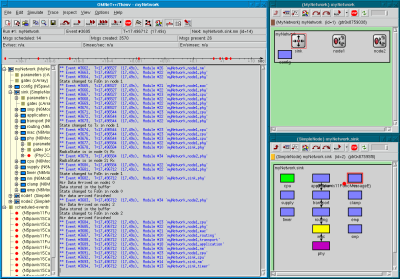
Within the PAWiS project a simulation framework for Wireless Sensor Networks (WSN) is developed. It provides functionality to simulate the network nodes with their internal structure as well as the network between the nodes. One main feature is the contemporaneous simulation of the power consumption of every single node. The framework is based on the discrete event simulator OMNeT++. The user defined model (expressed within C++ classes) is compiled to an executable simulator.
The primary simulation results consist of timing and power consumption profiles of the model. Additional outcome features a complete functional description and architecture specification along with low level implementation details developed during the modeling process.

The PAWiS framework is designed to ease development of wireless sensor network nodes regarding their MAC and routing protocol as well as hardware design issues. It is intended to be used in a cyclic development scenario with step by step optimization of the sensor network.
It provides classes to handle the inter-node communication that considers spatial distribution and noise within the network. Additionally it takes care of the bit error ratio and behaviour (timing, SNR) of transmissions. Environmental data is provided to simulate sensor readings.
Furthermore a distinct class to support the simulation of CPU related issues (including interrupt handling and low power modes) is provided to be adjusted by the user in order to match the target platforms requirements and capabilities.
A mechanism to utilize hierarchical power sources with various behaviour is also included and can be easily extended by the user.
The PAWiS Simulation Framework provides the facility to model all kind of nodes and networks. With the Interface Specification precisely defined modules and interfaces are given. The Module Library provides a set of implementations of such specified modules, e.g., a CSMA-MPS MAC module and an EADV routing module.
The simulation outputs a log file that consists of information regarding timing, power and events. It is parsed and analyzed by a special application written in C++ (with wxWidgets and OpenGL). The application allows the visualization and analysis of power consumption for each node with its modules and submodules as well as event marks.
Several data navigation helpers are included and additionally it is possible to apply various operations on the data rows like integrating or finding significant power peaks and more the like.
The current version of the Data Processing tool is rather limited.
More detailed information is available in the following documents
Scientific articles specifically on the PAWiS Simulation framework are offered for download below.
The PAWiS Framework as well as the Module Library are published under the terms of the GNU LGPL (Lesser General Public License). That means that you can download, use and redistribute them free of charge while your source code does not need to be licensed under the LGPL. The Data Processing Tool is released under the Terms of the GNU GPL (General Public License).
You are invited to utilize the framework and discuss your experience in the online forums. If you think your module should be added to the Module Library, we would be glad to integrate its source code.
The PAWiS Simulation Framework Version 2.0 was released on July 1st, 2008. It can be downloaded from the SourceForge.net release system.
The PAWiS Simulation Framework Version 2.1 will be released on October 6th, 2008. Besides error corrections it will contain more modules for the Module Library and better documentation as well as other improvements.
The PAWiS Simulation framework was originally developed at the Institute of Computer Technology at the Vienna University of Technology. The PAWiS Project was initiated to develop optimized wireless sensor nodes and specialized on the simulation framework, a wake-up receiver and ultra-low-power DC/DC converters.